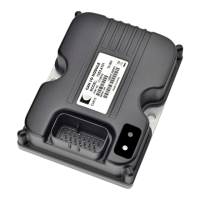2 — INSTALLATION AND WIRING
pg. 9
Return to TOC Curtis 1353 CANopen Expansion Module Manual – June 2017
Driver Outputs
All nine drivers (Pins 15–23) are identical. Each is capable of driving a closed-loop current-controlled
proportional valve or a voltage-controlled contactor. Each driver has independent mode, max, and
dither settings.
ese are high-power drivers. e internal impedance to ground will cause leakage current to ow
through the output even when the output driver is o. is leakage current can be enough (>2 mA)
to light high-eciency LEDs.
In the wiring diagram, the output at Pin 23 is shown driving a proportional valve coil. is driver is
programmed for Constant Current mode and would have some Dither applied.
e second output shown (Pin 22) is driving a basic contactor coil. is output is in the Constant
Voltage mode and can be set to run at a lower voltage than the nominal battery voltage.
Switch Inputs
All the outputs can be used as Active High inputs (“On” when connected to B+). It is important
that the output command be set to 0% for each input used or a direct short from B+ to B- will be
generated when the driver is pulsed On, which could damage the FET driver. In the wiring diagram,
I/O 9 (Pin 15) is shown as an Active High input switching to B+.
Analog Inputs
e fourth analog input (Pin 5) is shown being used with an RTD. is requires enabling the Analog
Input 4 pull-up, which allows the input to measure resistive sensors.
CANbus
e 1353 has an internal 1 kΩ bus termination resistor. is internal impedance matches the system
requirements for a mid-line connection or short stub connection. If the 1353 is to be used at the
end of the CANbus, an external 120 Ω ½W resistor must be added externally across the CAN H
and CAN L lines at or near the module to provide proper termination. e higher the bit rate (i.e.,
the higher the baud), the more critical this becomes. e 1353 can communicate up to 1 Mbit/s on
a properly terminated/wired bus.

